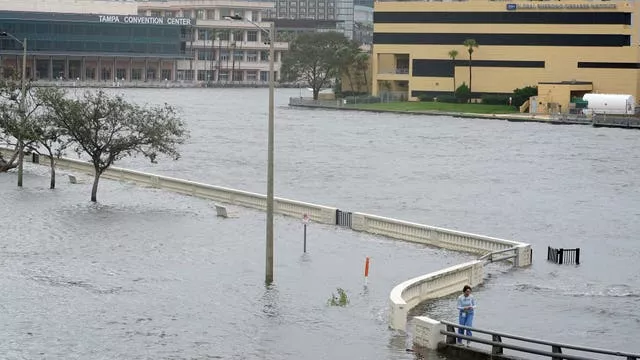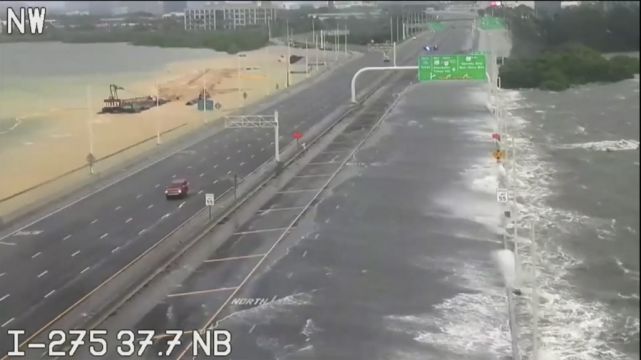Hurricane Idalia made landfall on Florida’s west coast as a catastrophic Category 3 storm on Wednesday, and unleashed life-threatening storm surges and rainfall across an area that has never before received such an onslaught.
More than 230,000 customers were without electricity as trees snapped by strong winds brought down power lines and rushing water covered streets.
Along the coast, some homes were submerged to near their rooftops and structures crumpled.
10 AM EDT Hurricane #Idalia Update: Damaging winds spreading into southern Georgia. pic.twitter.com/SNzWRQolZo
— National Hurricane Center (@NHC_Atlantic) August 30, 2023
Advertisement
As the eye moved inland, destructive winds shredded signs and sent sheet metal flying.
“We have multiple trees down, debris in the roads, do not come,” posted the fire and rescue department in Cedar Key, where a tide gauge measured the storm surge at 6.8ft, submerging most of the city centre.
“We have propane tanks blowing up all over the island.”
Idalia came ashore in the lightly populated Big Bend region, where the Florida Panhandle curves into the peninsula.
It made landfall as a high-end Category 3 hurricane with maximum sustained winds near 125 mph.
More than an hour later, it remained a Category 2 storm with top winds of 110 mph, and it was expected to remain a hurricane while crossing Florida east of Tallhassee, toward Valdosta, Georgia.

Forecasters said it would punish the Carolinas overnight as a tropical storm.
Some models predicted Idalia could circle southward toward land again after that, but the National Hurricane Centre forecast it to move deeper into the Atlantic this weekend.
Astounded by the flooding that turned Tampa’s Bayshore Boulevard into a river, Bill Hall watched a paddleboarder ride along the major thoroughfare.
“This is actually unbelievable,” Mr Hall said. “I haven’t seen anything like this in years.”
In Tallahassee, Florida’s capital city, the power went out well before the centre of the storm arrived.
Tallahassee mayor John Dailey urged everyone to shelter in place – it was too late to risk going outside.
The station is still reporting data - 6.74 feet as of 9:06am. Click on the little aqua pin by Cedar Key for the latest: https://t.co/xeMuNhlWrw https://t.co/Bzbop9svqL
— NOAA's Ocean Service (@noaaocean) August 30, 2023
Florida residents living in vulnerable coastal areas had been ordered to pack up and leave as Idalia gained strength in the warm waters of the Gulf of Mexico.
“Don’t put your life at risk by doing anything dumb at this point,” governor Ron DeSantis said at a news conference on Wednesday.
“This thing’s powerful. If you’re inside, just hunker down until it gets past you.”
Storm surge could rise as high as 16ft in some places. Some counties implemented curfews to keep residents off roads.
“For those who have chosen to remain on the beaches despite the mandatory evacuation order, please restrict your water and toilet usage,” the city of Clearwater posted.
“Due to flooding, the city’s lift stations and stormwater system are under strain.”

Diane Flowers was sound asleep at 1am on Wednesday in her Wakulla County home, but her husband was up watching the weather on TV, and got a text from their son when the storm was upgraded to a Category 4.
He is a firefighter in Franklin County, along the Gulf Coast.
“He said, ‘You guys need to leave’,” Mrs Flowers said. “And he’s not one for overreacting, so when he told us to leave, we just packed our stuff, got in our car and got going.”
The National Weather Service in Tallahassee called Idalia “an unprecedented event” since no major hurricanes on record have ever passed through the bay abutting the Big Bend.
The state, still dealing with lingering damage from last year’s Hurricane Ian, feared disastrous results.
But not everyone heeded the warnings.
River gauge in Steinhatchee rapidly increased this morning as storm surge moved in with the river gauge increasing from 1 ft to 8 ft in only 1 hour. Last observation was at 830am ET. When we say the storm surge threat would increase rapidly, this is what we meant. #Idalia #FLwx pic.twitter.com/5PfMAhbiie
— NWS Tallahassee (@NWSTallahassee) August 30, 2023
Andy Bair, owner of the Island Hotel on Cedar Key, said he intended to “babysit” his bed-and-breakfast, which predates the Civil War.
The building has not flooded in the almost 20 years he has owned it, not even when Hurricane Hermine flooded the city in 2016.
“Being a caretaker of the oldest building in Cedar Key, I just feel kind of like I need to be here,” Mr Bair said.
“We’ve proven time and again that we’re not going to wash away. We may be a little uncomfortable for a couple of days, but we’ll be OK eventually.”
Idalia had grown into a Category 2 system on Tuesday and became a Category 3 just hours earlier on Wednesday before strengthening to a Category 4 and then weakening slightly to a high-end Category 3.
Hurricanes are measured on a five category scale, with a Category 5 being the strongest. A Category 3 storm is the first on the scale considered a major hurricane and the National Hurricane Centre says a Category 4 storm brings “catastrophic damage”.
Though many eyes remain on the dangers #Idalia is bringing to the southeast, distant storm Hurricane #Franklin continues to stir up the western Atlantic, creating potentially deadly surf and rip currents along the US East Coast.
When visiting the ocean, you are safest at beaches… pic.twitter.com/YFCNUJ2OFM— National Weather Service (@NWS) August 30, 2023
Tolls were waived on roads out of the danger area and shelters were opened. More than 30,000 utility workers were gathering to make repairs as quickly as possible in the hurricane’s wake. About 5,500 National Guard troops were activated.
In Tarpon Springs, on the coast northwest of Tampa, 60 patients were evacuated from a hospital after warnings of a potential 7ft storm surge there.
Both Georgia governor Brian Kemp and South Carolina governor Henry McMaster announced states of emergency, freeing up state resources and personnel, including hundreds of National Guard troops.
On Tuesday President Joe Biden said he had spoken to Mr DeSantis and “provided him with everything that he possibly needs”.
The National Oceanic and Atmospheric Administration recently said the 2023 hurricane season would be far busier than initially forecast, partly because of extremely warm ocean temperatures.
The season runs until November 30, with August and September typically the peak.







